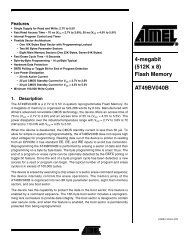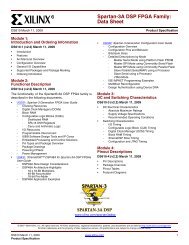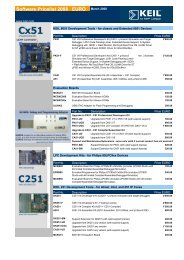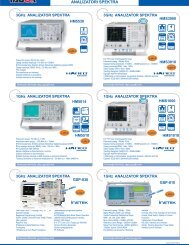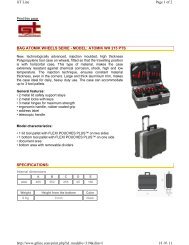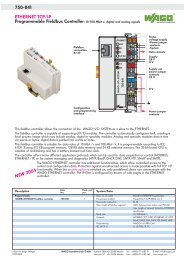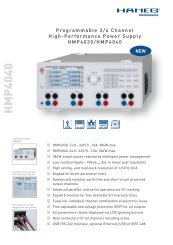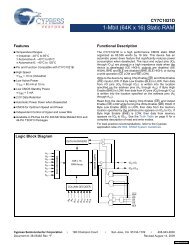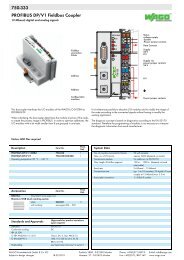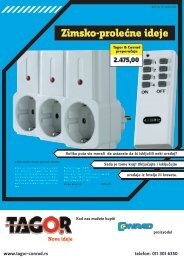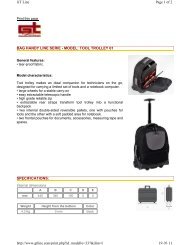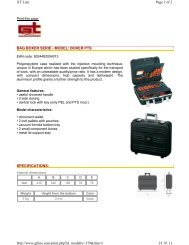PIC12F683 Data Sheet - Microchip
PIC12F683 Data Sheet - Microchip
PIC12F683 Data Sheet - Microchip
Create successful ePaper yourself
Turn your PDF publications into a flip-book with our unique Google optimized e-Paper software.
<strong>PIC12F683</strong><br />
3.8 Fail-Safe Clock Monitor<br />
The Fail-Safe Clock Monitor (FSCM) allows the device<br />
to continue operating should the external oscillator fail.<br />
The FSCM can detect oscillator failure any time after<br />
the Oscillator Start-up Timer (OST) has expired. The<br />
FSCM is enabled by setting the FCMEN bit in the<br />
Configuration Word register (CONFIG). The FSCM is<br />
applicable to all external oscillator modes (LP, XT, HS,<br />
EC, RC and RCIO).<br />
FIGURE 3-8:<br />
External<br />
Clock<br />
LFINTOSC<br />
Oscillator<br />
31 kHz<br />
(~32 μs)<br />
Sample Clock<br />
÷ 64<br />
488 Hz<br />
(~2 ms)<br />
FSCM BLOCK DIAGRAM<br />
Clock Monitor<br />
Latch<br />
3.8.1 FAIL-SAFE DETECTION<br />
The FSCM module detects a failed oscillator by<br />
comparing the external oscillator to the FSCM sample<br />
clock. The sample clock is generated by dividing the<br />
LFINTOSC by 64. See Figure 3-8. Inside the fail<br />
detector block is a latch. The external clock sets the<br />
latch on each falling edge of the external clock. The<br />
sample clock clears the latch on each rising edge of the<br />
sample clock. A failure is detected when an entire<br />
half-cycle of the sample clock elapses before the<br />
primary clock goes low.<br />
S<br />
R<br />
Q<br />
Q<br />
Clock<br />
Failure<br />
Detected<br />
3.8.3 FAIL-SAFE CONDITION CLEARING<br />
The Fail-Safe condition is cleared after a Reset,<br />
executing a SLEEP instruction or toggling the SCS bit<br />
of the OSCCON register. When the SCS bit is toggled,<br />
the OST is restarted. While the OST is running, the<br />
device continues to operate from the INTOSC selected<br />
in OSCCON. When the OST times out, the Fail-Safe<br />
condition is cleared and the device will be operating<br />
from the external clock source. The Fail-Safe condition<br />
must be cleared before the OSFIF flag can be cleared.<br />
3.8.4 RESET OR WAKE-UP FROM SLEEP<br />
The FSCM is designed to detect an oscillator failure<br />
after the Oscillator Start-up Timer (OST) has expired.<br />
The OST is used after waking up from Sleep and after<br />
any type of Reset. The OST is not used with the EC or<br />
RC Clock modes so that the FSCM will be active as<br />
soon as the Reset or wake-up has completed. When<br />
the FSCM is enabled, the Two-Speed Start-up is also<br />
enabled. Therefore, the device will always be executing<br />
code while the OST is operating.<br />
Note:<br />
Due to the wide range of oscillator start-up<br />
times, the Fail-Safe circuit is not active<br />
during oscillator start-up (i.e., after exiting<br />
Reset or Sleep). After an appropriate<br />
amount of time, the user should check the<br />
OSTS bit of the OSCCON register to verify<br />
the oscillator start-up and that the system<br />
clock switchover has successfully<br />
completed.<br />
3.8.2 FAIL-SAFE OPERATION<br />
When the external clock fails, the FSCM switches the<br />
device clock to an internal clock source and sets the bit<br />
flag OSFIF of the PIR1 register. Setting this flag will<br />
generate an interrupt if the OSFIE bit of the PIE1<br />
register is also set. The device firmware can then take<br />
steps to mitigate the problems that may arise from a<br />
failed clock. The system clock will continue to be<br />
sourced from the internal clock source until the device<br />
firmware successfully restarts the external oscillator<br />
and switches back to external operation.<br />
The internal clock source chosen by the FSCM is<br />
determined by the IRCF bits of the OSCCON<br />
register. This allows the internal oscillator to be<br />
configured before a failure occurs.<br />
© 2007 <strong>Microchip</strong> Technology Inc. DS41211D-page 29



